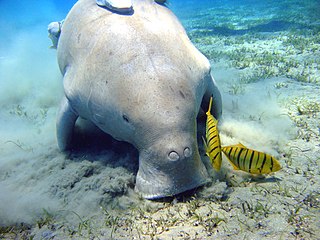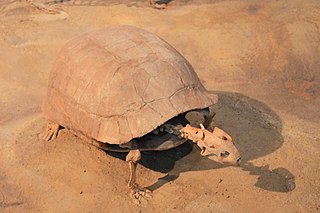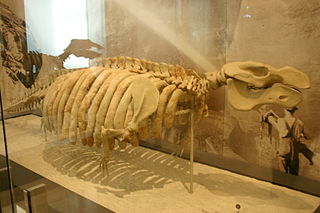
Dugongidae is a family in the order of Sirenia. The family has one surviving species, the dugong, one recently extinct species, Steller's sea cow, and a number of extinct genera known from fossil records.
Bolodon is a genus of extinct mammal from the Lower Cretaceous of Europe and North America. It was a member of the extinct order of Multituberculata and belongs to the suborder Plagiaulacida and family Plagiaulacidae.

Lontra is a genus of otters from the Americas.

Sphenacodontidae is an extinct family of small to large, advanced, carnivorous, Late Pennsylvanian to middle Permian pelycosaurs. Primitive forms were generally small, but during the later part of the early Permian these animals grew progressively larger, to become the top predators of their environments. Sphenacodontid fossils are so far known only from North America and Europe.

Thecocoelurus is a dubious genus of theropod dinosaur from the early Cretaceous period of England. It is paleontologically significant for being one of the first ornithomimosaur specimens known from England and represents the earliest record of Ornithomimosauria in Europe.
Paleontology or palaeontology is the study of prehistoric life forms on Earth through the examination of plant and animal fossils. This includes the study of body fossils, tracks (ichnites), burrows, cast-off parts, fossilised feces (coprolites), palynomorphs and chemical residues. Because humans have encountered fossils for millennia, paleontology has a long history both before and after becoming formalized as a science. This article records significant discoveries and events related to paleontology that occurred or were published in the year 1923.

Mourasuchus is an extinct genus of giant, aberrant caiman from the Miocene of South America. Its skull has been described as duck like, being broad, flat and very elongate, closely resembling what is seen in Stomatosuchus, an unrelated crocodylian that may also have had a large gular sac similar to those of pelicans or baleen whales. Mourasuchus, is a strange nettosuchid with an unusually long, broad snout.

Stylemys is the first fossil genus of dry land tortoise belonging to the order Testudines discovered in the United States. The genus lived in temperate to subtropical areas of North America, Europe, and Asia, based on fossil distribution. The genus was first described in 1851 by Joseph Leidy. The tortoise was common in the prehistoric Badlands, especially Nebraska and South Dakota. The species has also been found in the formations in and around Badlands National Park. Fossil fragments have also been found in the Palm Park Formation of New Mexico.

Metaxytherium is an extinct genus of dugong that lived from the Miocene until the end of the Pliocene. Fossil remains have been found in Africa, Asia, Europe, North America, and South America.
Palaeopsephurus is an extinct genus of paddlefish in the Acipenseriformes family Polyodontidae. At present the genus contains the single species Palaeopsephurus wilsoni.
Charactosuchus is an extinct genus of crocodilian. It was assigned to the family Crocodylidae in 1988. Specimens have been found in Colombia, Brazil, Jamaica, and possibly Florida and South Carolina. It was gharial-like in appearance with its long narrow snout but bore no relation to them, being more closely related to modern crocodiles than to gharials.

Ptychoceratodus is an extinct genus of prehistoric sarcopterygians or lobe-finned fish originally named as a species of Ceratodus in 1837. It was a lungfish from the Mesozoic era (Triassic-Cretaceous), and the only members of the family Ptychoceratodontidae. One species, P. oldhami, was named in 2018 based on remains from the Carnian-aged Tiki Formation (India). The first named species, which is also the type species, is P. phillipsi, which was named in 1837 by Louis Agassiz as a species of Ceratodus and moved to a separate genus in 1926.

Macrocranion is a genus of extinct mammal from the Eocene epoch of Europe and North America. Exceptional fossils have has been found in the Messel Pit of Germany. Macrocranion species are often described as forest-floor predators, about the size of small squirrels but with longer limbs. The genus is represented at the Messel Pit site by two species, M. tupaidon and M. tenerum.

Halysites is an extinct genus of tabulate coral. Colonies range from less than one to tens of centimeters in diameter, and they fed upon plankton.

Phenacodontidae is an extinct family of large herbivorous mammals traditionally placed in the “wastebasket taxon” Condylarthra, which may instead represent early-stage perissodactyls. They lived between the Paleocene and Eocene epochs and their fossil remains have been found in North America and Europe, and it is closely related to the horse.
Vritramimosaurus is an extinct genus of large early archosauromorph. Although originally placed in the family Prolacertidae, recent studies on archosauromorph relationships doubt the validity of the family, at least in its broadest sense. Fossils have been found from Early Triassic deposits of the Rassypnaya locality in Orenburg Oblast, Russia. Rassypnaya is located on the Obshchy Syrt, a plateau in the European part of Russia that extends southwest of the Urals toward the Volga River. Vritramimosaurus is similar to the later genus Malutinisuchus, also from Rassypnaya but present in Middle Triassic deposits.
Praenuculinae is an extinct subfamily of prehistoric bivalves in the family Praenuculidae. Praenuculinae species lived from the middle Ordovician through the late Devonian. Praenuculinae fossils are found in Europe, Africa, North America and South America, and species are thought to have been stationary attached to substrate in shallow infaunal marine water environments where they formed shells of an aragonite composition. The subfamily Praenuculinae was named by Teresa M. Sánchez in 1999.
Coelodontognathus is an extinct genus of reptile from the Early Triassic of European Russia. It was originally described as a procolophonid parareptile in 1967 but was reclassified as a possible trilophosaurid archosauromorph in 2008. The genus includes two species: the type species C. donensis and C. ricovi. C. donensis is known from the holotype PIN 4173/129 and the referred PIN 4173/130, and C. ricovi is known from the holotype PIN 4173/127 and the referred PIN 4173/128, all of which represent dentaries that are housed at the Paleontological Institute, Russian Academy of Sciences. Another dentary, SGU 104/3105, originally referred to C. donensis was reassigned to its own genus and species Vitalia grata by Ivakhnenko, 1973. The fossils have been found at the Donskaya Luka Locality near the village of Sirotinskaya and the Don River in Ilovlinsky District, Volgograd Oblast, from the Lipovskaya Formation of the Gamskii Horizon. Like Coelodontognathus, Vitalia which is known from the same locality was also first identified as a procolophonid and later reclassified as a trilophosaurid. Coelodontognathus and Vitalia are similar to procolophonids in that they have wide teeth but differs from them in that they have tooth roots set deep into the jaws.
Vitalia is an extinct genus of reptile from the Early Triassic of European Russia known from the type species V. grata. It is known from the holotype dentary PIN 4173/126 as well as two additional dentaries PIN 1043/627 and 1043/628, all housed at the Paleontological Institute, Russian Academy of Sciences. The type dentary was originally included in the hypodigm of Coelodontognathus donensis named by the notable Russian vertebrate paleontologist Vitaliy Georgiyevich Ochev in 1967. Ivakhnenko (1973) separated the specimen and gave it its own genus and species name in light of the new material, which he named in honor of Ochev. The dentaries of Vitalia were collected at the Donskaya Luka Locality near the village of Sirotinskaya in Ilovlinsky District, Volgograd Oblast, from the Lipovskaya Formation of the Gamskii Horizon. Like Coelodontognathus, Vitalia was originally described as a procolophonid parareptile in 1973, but Arkhangelskii & Sennikov (2008) reclassified the taxon as a possible trilophosaurid archosauromorph. Vitalia is thought to be similar to the possible trilophosaurids Coelodontognathus and Doniceps, both of which are known exclusively from the same locality. Coelodontognathus and Vitalia are similar to procolophonids in that they have wide teeth but differs from them in that they have tooth roots set deep into the jaws.

Peradectes is an extinct genus of small metatherian mammals known from the Cretaceous and Paleocene of North and South America through the Eocene of North America and parts of Europe. The first discovered fossil, P. elegans, was one of 15 Peradectes specimens described in 1921 from the Mason pocket fossil beds in Colorado.












